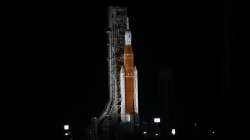NASA spacecraft buzzes Jupiter moon Europa, closest in years
John Bordi, deputy mission manager at NASA's Jet Propulsion Laboratory, expected the spacecraft to go “screaming by pretty fast,” with a relative velocity of almost 15 miles per second (23.6 kilometers per second).

NASA's Juno spacecraft has made the closest approach to Jupiter's tantalizing, icy moon Europa in more than 20 years. Juno on Thursday zipped within 222 miles (357 kilometers) of Europa, thought to have an ocean flowing beneath its thick frozen crust, raising the possibility of underwater life.
Scientists hope to get lucky and observe possible water plumes shooting from the surface of Europa, close in size to Earth's moon. “We have to be at the right place at just the right time, but if we are so fortunate, it's a home run for sure," Juno's chief scientist, Scott Bolton of Southwest Research Institute in San Antonio, said in a statement.
John Bordi, deputy mission manager at NASA's Jet Propulsion Laboratory, expected the spacecraft to go “screaming by pretty fast,” with a relative velocity of almost 15 miles per second (23.6 kilometers per second). Pictures should be available by Friday, NASA said. The latest observations will help NASA plan for its Europa Clipper mission, due to launch in 2024. The European Space Agency also plans close encounters with its Jupiter Icy Moons Explorer, or Juice, lifting off next year. NASA's former Galileo spacecraft still holds the Europa flyby record, passing within 218 miles (351 kilometers) in 2000.
ALSO READ | Bam! NASA spacecraft crashes into asteroid in historic defense test | WATCH
ALSO READ | NASA delays moon rocket launch due to potential hurricane
